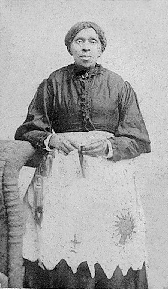Harriet Powers was born a slave in Georgia on October 29, 1837. It is assumed that she was raised as a house slave and learned to sew as a child. She is best known for two magnificent story quilts she made after the Civil War. For over 125 years the Bible Quilt and the Pictorial Quilt she stitched have been closely studied for what they could tell historians and museum curators about African American folk art and the lives of slaves after the Civil War. Because she was a slave, scholars assumed she was illiterate. This assumption had often been used by scholars to explain the so called primitive look of the appliqué figures she used on her quilts to tell stories from the Bible and her life.
Powers’ life and quilts seemed to be so well known; Hicks originally intended her book to be a simple annotated bibliography. However, as she pored over the sources she began to notice that some researchers, made statements about Mrs. Powers and her quilts without citing verifiable references. Curious, Hicks decided to make a game of challenging what she read, and like the fictional African American woman detectives she admires in her favorite mystery novels, Hicks began to ask new questions about Harriet Powers and her famous quilts. Questions like: Was Powers really illiterate? What was the exact chain of custody or historical background for each quilt? Had Powers created other quilts and where were they if she had?
As if to make sure that everyone understood exactly where she was coming from, Powers triumphantly signed her letter: This I Accomplish, Harriet A. Powers.
It is because Hicks decided to ask what she didn’t know as opposed to accepting as fact what others had written that we readers are now blessed to have the full story of both the Pictorial Quilt and the Bible Quilt. We now know in intricate detail the movements of each quilt from one interesting owner to the next on their journey to their final homes in The National Museum of American History at the Smithsonian Institution in Washington D.C and the Museum of Fine Arts in Boston, Massachusetts. In addition, we also get to experience Hick’s joy and astonishment when her hard work and curiosity pays off in the discovery of an incredible letter written by Powers herself. In the letter, the quilter states not only that she was literate but also how she became so. She also declares that she was the creator of at least three other quilts and represented her own artwork at fairs and shows. As if to make sure that everyone understood exactly where she was coming from, Powers triumphantly signed her letter: This I Accomplish, Harriet A. Powers.
The story of the discovery of the letter and the stories of the people who owned the quilts would have been enough to make This I Accomplish special, but Hicks goes above and beyond this. In the second half of the book she presents a complete annotated bibliography including books, articles, poems, plays, exhibits and other media. She also presents timelines that help place Powers and her quilts in context with what was going on in the rest of the world. And as if to pass on the baton of her meticulous research, Hicks offers in the concluding pages of her book, questions and ideas for future historians, museum curators, and quilters to work on. Examples of future projects range from: locating other quilts by Powers, to the petitioning the Postal Service to issue a commemorative stamp celebrating the 185th anniversary of her birth in 2012.
I loved this book. The new research it uncovered about Powers and her life made my heart sing and after a long hiatus of just writing fiction, I felt the need to go back to my first love of quilting. I am deeply grateful to both Kyra Hicks and the magnificent quilt artist, Mrs. Harriet Angeline Powers, for reviving my passion of telling stories with fabric.
About the guest reviewer
Karen Simpson in Ann Arbor Michigan. Writing, fabric art and history are her passions. She taught African American quilting for over twenty years before her focus shifted to stitching words together to create fiction. Her debut speculative novel Act of Grace will be published in February 2011 by Plenary Publishing. In the novel Grace Johnson, an African American high school senior saves the life of a Klansman and everyone in her hometown of Vigilant, Michigan wants to know why. With insight shaped by voices of ancestors and spirits Grace bears witness to her towns violent racial history so the all involved might transcend it. More information can be found on Karen’s blog Grace Notes.



6 comments:
Thank you for having the author and the book. Really enjoyed.
This is very interesting! I can't wait to read this book. So much of history is based on outdated assumptions that are presented as fact. I'm glad that this writer chose to question "what we know" and as a reward she found something wonderful!
An interesting review of what sounds like a fascinating book. Thanks, Karen and Carleen!
Thank you for sharing this review. I've read the book and thought it was remarkable in many respects.
What an interesting story from my favorite time period! I'm going to add it to my list of books TBR.
This looks really great! I can't wait to add it to my collection. Fascinating history. Thanks for posting this.
Post a Comment